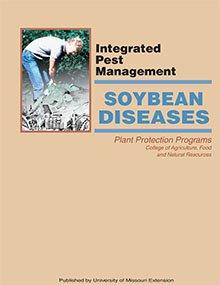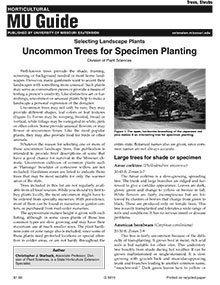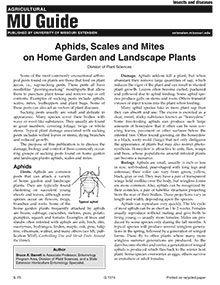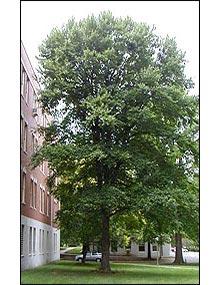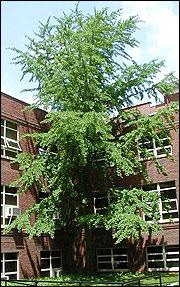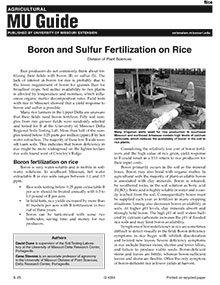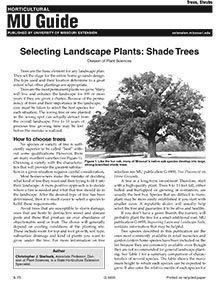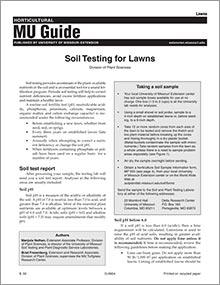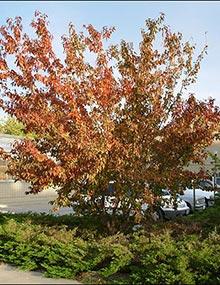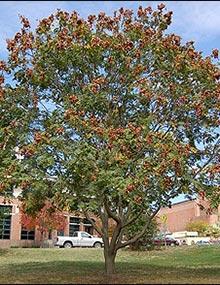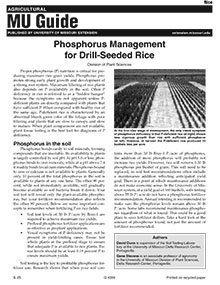Soybean Diseases
Revised
Editor's note
The following abstract describes a publication that is only available as a downloadable PDF.
Selecting Landscape Plants: Shade Trees - Page 25
Revised
Trident maple (Acer buergeranum) Small trees
Selecting Landscape Plants: Shade Trees - Page 28
Revised
White oak (Quercus alba) Large trees
Selecting Landscape Plants: Uncommon Trees for Specimen Plantings
Reviewed
Check out some uncommon landscape trees that have a good chance for survival in the Missouri climate.
Aphids, Scales and Mites on Home Garden and Landscape Plants
Revised
Piercing-sucking pests such as aphids, scales and mites are commonly found on home garden and landscape plants. Learn how to identify and control them in this University of Missouri Extension guide.
Selecting Landscape Plants: Shade Trees, Page 02
Revised
American sycamore or plane tree (Platanus occidentalis)
Selecting Landscape Plants: Shade Trees, Page 05
Revised
Black gum (Nyssa sylvatica)
Selecting Landscape Plants: Shade Trees, Page 08
Revised
Ginkgo (Ginkgo biloba)
Selecting Landscape Plants: Shade Trees - Page 11
Revised
Honey locust (Gleditsia triacanthos var. inermis) Large trees
Selecting Landscape Plants: Shade Trees - Page 14
Revised
Linden (Tilia spp.) Medium-sized trees
Selecting Landscape Plants: Shade Trees - Page 17
Revised
Red maple (Acer rubrum) Large trees
Selecting Landscape Plants: Shade Trees - Page 20
Revised
Siberian elm (Ulmus pumila)
Large trees
Maximum height
70 feet
Relative growth rate
Excellent
Freedom from insect pests
Very poor
Freedom from disease problems
Poor
Resistance to storm damage
Very poor
Will grow on poorly drained soil
Selecting Landscape Plants: Shade Trees - Page 23
Revised
Swamp white oak (Quercus bicolor) Large trees
Selecting Landscape Plants: Shade Trees - Page 26
Revised
Tulip tree (Liriodendron tulipifera) Large trees
The Bagworm in Missouri
Revised
Selecting Landscape Plants: Shade Trees - Page 29
Revised
Yellowwood (Cladrastis kentukea) Medium-sized trees
Soil Testing for Lawns
Reviewed
Periodic soil testing helps you correct nutrient deficiencies, avoid excess fertilizer applications and maintain a healthy lawn. Learn when routine soil testing makes sense and what it analysizes in this University of Missouri Extension guide.
Selecting Landscape Plants: Shade Trees, Page 03
Revised
Amur maple (Acer ginnala)
Mulches
Revised
Mulches provide many benefits to plants. Benefits vary with the material used, the type of soil, the kind of plant and the cultural practices used. Mulches also may be used to make landscapes more attractive and usable and to reduce the amount of maintenance work (Figures 1a to 1c).
Selecting Landscape Plants: Shade Trees, Page 06
Revised
Bur oak (Quercus macrocarpa)
Selecting Landscape Plants: Shade Trees, Page 09
Revised
Golden-rain tree (Koelreuteria paniculata)
Selecting Landscape Plants: Shade Trees - Page 12
Revised
Horse chestnut (Aesculus hippocastanum) Large trees
Selecting Landscape Plants: Shade Trees
Revised
Learn how to select the perfect shade trees for your midwest yard or landscape. Don't waste years on a bad landscape!
